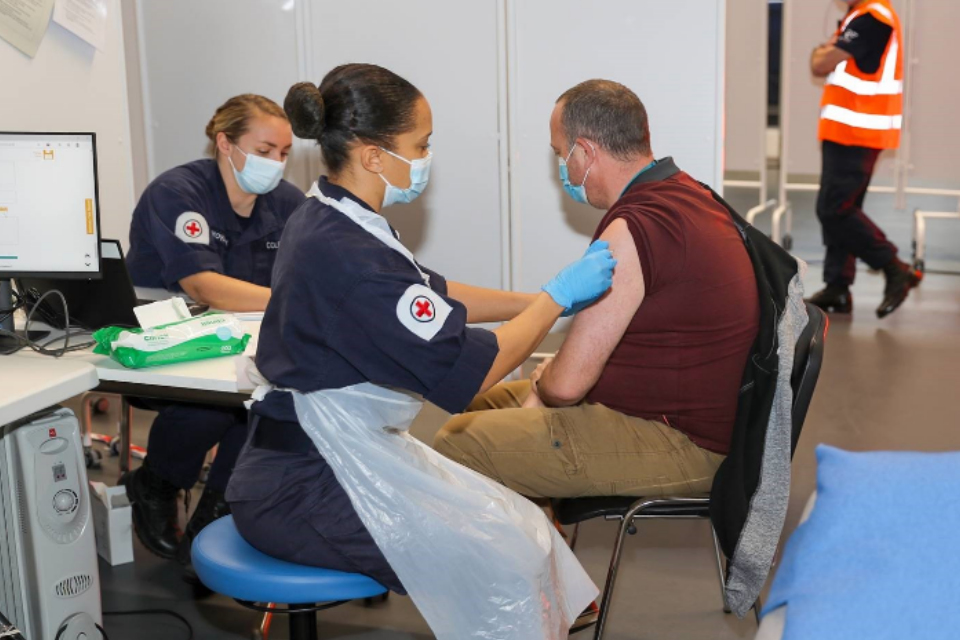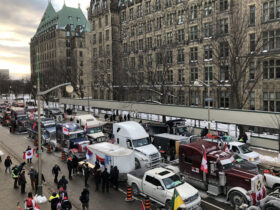The lockdown of 2020 cost me my job, so I jumped at the chance to train as vaccinator: two days online training and two in a classroom, where we learned about T-Cells and practiced on foam rubber arms (“they used an orange in my day” said the trainer).
It was good fun vaccinating in the spring of 2021. The first people we saw were in their seventies and eighties. They were chipper and good fun to talk to—south Londoners who had lived full lives. As the season grew warmer younger people were invited in.
Injecting is pretty easy; it was a lot harder to navigate the two online pre-screening forms, one belonging to the National Immunization and Vaccination System (NIVS), and the other, the local health authority. Vaccinees had to wait while the “computer said no,” getting more anxious.
Early on, there was an ethnic monitoring form. “Can I put white British?” “Too right!” the pensioners would answer, drawing eye-rolls from the vaccinators. “Jewish” said one man, who was already fed up with us misspelling his name. I had to tell him that the pull-down menu did not offer Jewish as a choice, and both of us quoted the title of David Baddiel’s book, Jews Don’t Count, in tandem. Later, that question was dropped.
The sentiment behind the vaccine program was pretty optimistic in those first months. Financial Times journalist John Burn-Murdoch’s calculations showing that the vaccination of older people greatly helped turn the tide of COVID infections are compelling. The mood of people coming in was enthusiastic and supportive. It should be said, too, that the vaccination program—both the development of AstraZeneca’s vaccine and its roll-out—was one of the few things that the government got right, in a pretty desperate time. Other projects, like track and trace, were just money pits that did not work.
How it happened where I worked was that the vaccination hubs were physically separated from the hospitals in tents (like the circus, the excitement was intense), but also organizationally. The hubs were run by senior nurses who had all been recruited and trained in the last 10 years. The vaccinators worked an eleven and a half-hour shift (with three breaks of 30, 15 and 15 minutes each), for which you would take home around £150. Open shifts were posted up on a website every week and you grabbed what you could. Guys and St. Thomas’s Hospital Trust ran their vaccination program on zero hour contracts.
“What ought to have been a medical program drifted into an technocratic authoritarian regime of social control.”
It was pretty Spartan in the pods where you would work either alone or in pairs. The tents were freezing in the winter and sweltering in the summer. Many of the vaccinators I worked with were medical students, whose courses had been suspended. We talked to patients, but not that much with each other. People were rushed through like it was a McDonald’s. The churn was pretty relentless.
Early on I turned up in a Hawaiian shirt, which was the only short-sleeved shirt I had. A huffy head nurse tossed me a Fruit of the Loom polo shirt with the Guys Hospital logo and “vaccination team” printed on it and told me to change. Later on, I was working with a man named Sharif, who told me about Liberia and wondered why he had not been given a polo shirt. During our quarter-hour break we hunted down supplies. A depressed administrator did not want to give them up, insisting that unless we were working more than three shifts we only needed one shirt. After we argued she gave us one “Vaccination Service” commemorative water bottle each.
Working for Guys and St Thomas’s “Staff Bank” is its own kind of hell. They commonly forget to pay you, and only communicate through email. (The Trust says its values include “taking pride in what we do, respecting others, striving to be the best and acting with integrity,” which was not my experience with the Staff Bank.) I thought I might have offended someone, so often did my wages not appear, but after talking to others it was apparent that being paid on time was as likely as like getting blood out of a stone.
The vaccination program began to feel a bit like a religious calling by the summer. The enthusiasm with which people were told to get vaccinated began to feel like an ideological injunction as much as a health concern. The vaccination drive became the government’s flagship policy, the one that worked, and so the eligible age cohorts were set lower and lower.
The language shifted to become more judgmental. People wanted the unvaccinated to be barred from public spaces and the National Health Service App was used as a prototype vaccine passport in clubs and music venues. This new sanctimony meshed well with the authoritarian mood established in lockdowns. It was a minor scandal over the summer that NHS workers were on average less likely to be vaccinated than the public (the numbers on this are hard to show, and in any event a big push from NHS managers reversed that by the autumn). Two of my managers in other parts of the Trust were unvaccinated. They were guarded about their reasons, fearing the contempt of their fellows. By December both had decided to get the jab.
Hospitals closed down many services and clinics to focus of COVID and—paradoxically—around one-fifth fewer patients were seen at the height of the pandemic than during normal times. Doctors and nurses were sent to the COVID wards, while many clerical and non-medical staff worked from home or were home shielding. The Trusts struggled to cope with staff shortages as many fell ill with COVID (as did I while working at Guys). Signs went up in corridors saying that we were to turn off the NHS apps on our phones because too many people were being sent home after being pinged.
The awkward truth is that the anti-vaxxers had a point. No. Not that one. The vaccine wasn’t made in a Wuhan lab by Dr. Fauci in a bid to take over the world. COVID is a serious illness, not a hoax. But the way that states responded to the crisis was predicated on their previous relationship with their electors, and that is not good. What ought to have been a medical program drifted into an technocratic authoritarian regime of social control.
In the years before COVID western states had all retreated from public engagement and debate, as the rival ideologies of socialism and free markets lost their explanatory power for any significant popular base. Instead, states have preferred to depoliticize their rule—treating questions of social administration as mere technical issues that required the right experts.
The COVID pandemic slotted into that paradigm. In the UK, instead of Parliamentary debate, public policy was represented by medical officers Chris Whitty and Patrick Vallance lecturing the country with PowerPoint slides. The country was put under curfew. Freedom of movement was suspended. Opposition was modest, but even those few who protested against the measures were arrested and their demonstrations broken up. Social media was censored. The fundamental failing of the public health campaign was that it did not trust the public. Instead of persuasion, the government chose coercion. Even the vaccination program, which enjoyed enthusiastic public support, was incorporated into a moralizing lecture about the foolish or bad unvaccinated versus the good, virtuous vaccinated. What was good about the vaccination program was that it was voluntary, but the order that NHS workers had to be vaccinated or sacked stood that on its head.
When the omicron variant was first identified the panic was marked, and the vaccine program relaunched (bear in mind that the Scientific Advisory Group was warning of as many as ten thousand hospitalizations a day in December). But there were some notable differences. First, we were seeing much younger people—sixteen upwards, some arriving in their school uniforms. I could not see any advantage to them in getting vaccinated since they were at no observable risk.
With the government taking up omicron-alarmist, vaccine-boosting advertisements on the front pages of most newspapers, the December workload was big. At one point a queue a quarter of a mile long waited outside the St. Thomas’s vaccination hubs. Standing in the cold was probably as big a threat to their health as omicron. The army turned up to help us out. I had a cheerful co-worker in army fatigues who ordinarily worked as a dog-handler. A young woman looked sharply at him and asked me why the army had to be there. “At least if he’s here he can’t be invading anywhere else,” I joked, which probably irritated the both of them.
The other change was that the UK government had announced that NHS workers who did not get vaccinated would lose their jobs. People turned up in my pod who were not happy, but cowed, and even angry. One was a Filipino man who worked in the hospital laundry. His boss had told him that he had to get vaccinated to keep his job. A woman who worked as an administrator in an Afro-Caribbean old people’s day center told me the same. Neither were in patient-facing jobs and were not any kind of “threat” to anyone.
In the NIVS pre-screening (and again in the Trust’s) there is a question about consent. Often doctors I worked with would brush over this step on the grounds that it was already positively implied by the person arriving at the vaccine center, but I always thought it good idea to make the point to patients that the procedure was their choice. On these occasions, however, I was told that it was not. “If you do not consent,” I said, “I cannot vaccinate you.” “I want you to put down that I do consent, because I have to get vaccinated to keep my job,” I was told, “but I do not consent.”
One young man had come in with his mother who said he was nervous. My army friend took this as a challenge and crouched down beside his chair to face him down. The boy was petrified, and really we should have sent him home. But after a quarter of an hour-long staring match with the British army, he relented and let himself be jabbed.
The non-appearance of the expected omicron wave of hospitalizations took the wind out of the vaccination drive. Journalist John Burn-Murdoch is right that vaccination helped to beat down the January 2021 peak, but in the end it was the omicron variant, milder in impact than the previous waves, but more infectious, that brought the pandemic to an end. It seemed like everyone caught it, but deaths and hospitalizations did not rise to the extent feared. Like Canute, we learned that you cannot turn back the tide.
We turned up in January 2022 prepared for thousands, but there were hardly any, and a troop of soldiers were fighting us for those that did turn up. I was put to work entering data in a windy tent. The only shifts appearing on the work roster were in schools, and then there were none at all.
The government relented on its threat to sack unvaccinated staff, which is a good thing in my opinion. Their number was in truth overstated. One million two hundred thousand NHS staff are vaccinated, and less than one in twelve are not. The likelihood of your catching COVID from an unvaccinated nurse or doctor today is vanishingly rare. There was no good reason for the government to pick a fight with unvaccinated NHS workers. It was just a propagandistic gesture to make it look like Secretary of State for Health and Social Care Sajid Javid was doing something. In any event, it was over. The tents are empty now. Probably a few were blown over by Storm Eunice.









